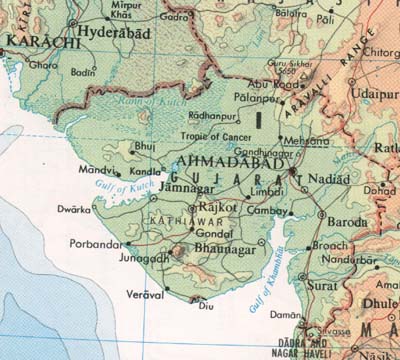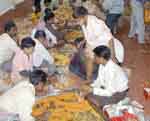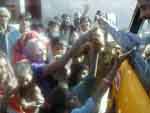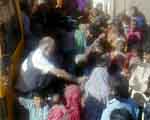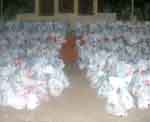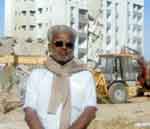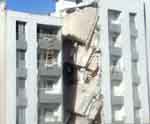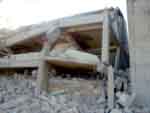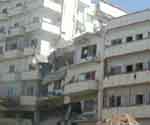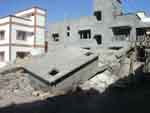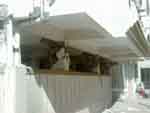When I arrived at the Ashram at 9:45 Wednesday night, the truck had already been loaded with self sufficiency bags and some water (in 250ml plastic bags), and the bus had been loaded with mostly water. I was disappointed to see that it was the same bus we had used earlier, because it had a bad wobble in the front end between about 40 and 50 KPH. The truck left first, and then we set out at about 11PM in the bus. We met the truck at about 1AM disabled due to a fuel leak, and its entire load was transferred into, and on top of, the bus.
|
We continued northwest from Rajkot and sometime during the night crossed the Suraj Bari bridge across the northeastern end of the Gulf of Kutch. This bridge was closed immediately after the quake, then reopened, then closed to heavy trucks. When we crossed, they were allowing traffic in one direction at a time, and at a very slow speed. This is a long, low bridge crossing shallow water and mud flats and it consists of multiple spans. The supporting columns settled unevenly during the quake, so the bridge surface pitches up or down at the end of each span.
At about 5AM, we reached Danaty Village (which is being used as a relief distribution center), where we slept until dawn. Most of the buildings around the compound where we stopped were badly damaged but were still standing. Residents and relief workers slept in the open. After unloading the bus into a storage room, we set out for Bhuj, about 40 km away.
The drive to Bhuj took us through open country with some farming. There were not many buildings, but those we passed appeared to be heavily damaged. As we got close to Bhuj, the traffic became very heavy and included flatbed trailers carrying tanks of water, heavy equipment—cranes and bulldozers, buses and trucks loaded with relief supplies, army vehicles, and official cars. We dropped off a doctor we had brought from Rajkot and then went to the Shri Ramakrishna Ashram in Bhuj. I was told that I had one hour before we left, and I set out to see what I could see in the nearby areas of the city.
From what I had heard, I expected to see blocks and blocks of rubble with few buildings standing. What I saw was about 10% collapsed buildings. But most of the buildings that remained standing had visible cracks or other serious damage, and I expect that a large portion of the standing building will have to be razed. I had heard that 50% of the people in Bhuj had been killed. I do not now believe that to be correct; 10% seems more likely if the area I saw is representative of the city as a whole.
While I was looking at one group of three badly damaged apartment buildings, a man came over to me and introduced himself as Mr. H. D. Joshi. He said that he had lived on the ground floor of the third building and had gone to a friend’s house at about 8:15 last Friday morning, leaving his wife, daughter, and granddaughter at home. The earthquake struck about a half hour later and lasted about five seconds. His apartment remained intact, but he believes that his family fled the apartment into the space between the second and third buildings and were buried when the second building collapsed. He said that it was two or three days before any rescue was attempted, but the army is now working long hours with heavy equipment and he is standing watch, hoping that his family will be found alive.
As we headed east from Bhuj toward the Gulf of Kutch, we passed piles of clothes at the side of the road, apparently dropped by relief workers who didn’t know how else to get them to victims. We passed many concrete bus stands, and not one was standing. The villages we passed really did appear to be blocks of rubble with few buildings standing. Because of the high percentage of collapsed buildings, and the long delay before any outside help reached most villages, I believe that the number of casualties in the villages will be very high.
Once we crossed the Gulf of Kutch, leaving the Kutch district for the Rajkot district, the damage we saw was obviously much less. In an earlier report, I said that Rajkot was about 50 miles from the quake epicenter near Bhuj. I think that the straight-line distance is more like 80-90 miles but, in any case, we were very lucky in Rajkot. It will be a very long time before Bhuj is restored to anything close to normal. Some of the villages will probably never be the same.
